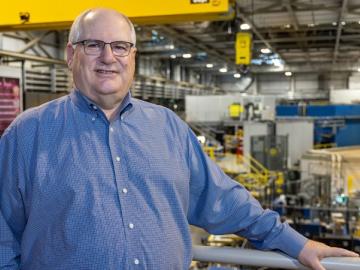
Filter News
Area of Research
- (-) Computer Science (15)
- (-) Energy Science (108)
- (-) Neutron Science (129)
- Advanced Manufacturing (8)
- Biology and Environment (62)
- Building Technologies (2)
- Computational Biology (1)
- Computational Engineering (3)
- Electricity and Smart Grid (1)
- Energy Frontier Research Centers (1)
- Energy Sciences (1)
- Functional Materials for Energy (1)
- Fusion and Fission (8)
- Fusion Energy (2)
- Isotopes (1)
- Materials (97)
- Materials for Computing (21)
- Mathematics (1)
- National Security (30)
- Nuclear Science and Technology (7)
- Quantum information Science (8)
- Supercomputing (135)
News Topics
- (-) Computer Science (45)
- (-) Frontier (3)
- (-) Machine Learning (13)
- (-) Nanotechnology (17)
- (-) Neutron Science (121)
- (-) Polymers (12)
- 3-D Printing/Advanced Manufacturing (83)
- Advanced Reactors (6)
- Artificial Intelligence (20)
- Big Data (11)
- Bioenergy (31)
- Biology (18)
- Biomedical (20)
- Biotechnology (5)
- Buildings (38)
- Chemical Sciences (17)
- Clean Water (10)
- Composites (18)
- Coronavirus (22)
- Critical Materials (9)
- Cybersecurity (10)
- Energy Storage (75)
- Environment (59)
- Exascale Computing (3)
- Fossil Energy (3)
- Fusion (2)
- Grid (40)
- High-Performance Computing (10)
- Hydropower (3)
- Isotopes (1)
- Materials (46)
- Materials Science (49)
- Mathematics (3)
- Mercury (3)
- Microelectronics (1)
- Microscopy (10)
- Molten Salt (1)
- National Security (7)
- Nuclear Energy (9)
- Partnerships (12)
- Physics (10)
- Quantum Computing (1)
- Quantum Science (10)
- Security (8)
- Simulation (4)
- Space Exploration (6)
- Statistics (1)
- Summit (10)
- Transportation (68)
Media Contacts

ORNL is teaming with the National Energy Technology Laboratory to jointly explore a range of technology innovations for carbon management and strategies for economic development and sustainable energy transitions in the Appalachian region.

A scientific instrument at ORNL could help create a noninvasive cancer treatment derived from a common tropical plant.

Warming a crystal of the mineral fresnoite, ORNL scientists discovered that excitations called phasons carried heat three times farther and faster than phonons, the excitations that usually carry heat through a material.

Natural gas furnaces not only heat your home, they also produce a lot of pollution. Even modern high-efficiency condensing furnaces produce significant amounts of corrosive acidic condensation and unhealthy levels of nitrogen oxides

Researchers from Yale University and ORNL collaborated on neutron scattering experiments to study hydrogen atom locations and their effects on iron in a compound similar to those commonly used in industrial catalysts.

The truth is neutron scattering is not important, according to Steve Nagler. The knowledge gained from using it is what’s important

Paul Langan will join ORNL in the spring as associate laboratory director for the Biological and Environmental Systems Science Directorate.

David McCollum, a senior scientist at the ORNL and lead for the lab’s contributions to the Net Zero World Initiative, was one of more than 35,000 attendees in Egypt at the November 2022 Sharm El-Sheikh United Nations Framework Convention on Climate Change, or UNFCCC, Conference of the Parties, also known as COP27.

While studying how bio-inspired materials might inform the design of next-generation computers, scientists at ORNL achieved a first-of-its-kind result that could have big implications for both edge computing and human health.

Oak Ridge National Laboratory scientists designed a recyclable polymer for carbon-fiber composites to enable circular manufacturing of parts that boost energy efficiency in automotive, wind power and aerospace applications.


